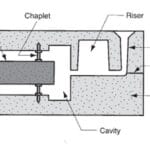Pattern is the mirror image or replica of the component that has to be manufactured by casting. A pattern prepares the mould cavity for the casting process.
- Materials used for pattern making:
- The selection of pattern material depends on following factors
(i) No. of products to be cast. (For mass production metal pattern is used)
(ii) Desired dimensional accuracy and surface finish.
(iii) Shape complexity and size of the castings.
(iv) Type of moulding materials.
(v) Type or nature of moulding process.
Based on the above factors different types of pattern materials are used in casting process.
Wood: The most common material used for pattern making is wood because of its easy availability, low weight, can be easily shaped, and is relatively cheap. The most common pattern wood is mahogany and teak wood.
The main disadvantage of wood is its absorption of moisture as a result of which distortions and dimensional changes (shrinkage) occur. They can’t withstand rough handling.
Metal: Metal patterns are used where large number of parts to be manufactured by casting. Metal patterns are made from a wooden pattern. Metals like grey cast iron, brass aluminium alloys are used for pattern making.
Wax: The wax pattern is taken into consideration only for the easiness in fabrication into the complex shape of the casting.
Plastic: The most commonly used plastics are Polystyrene, Nylon, PVC etc. Polystyrene is used for the manufacturing of very large size casting.
